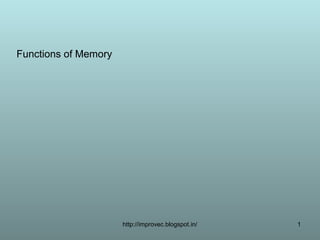
Functions of Memory Types
- 1. Functions of Memory http://improvec.blogspot.in/ 1
- 2. Objective: On completion of this period, you would be able to learn Functions of memory. Types of memory. http://improvec.blogspot.in/ 2
- 3. Recap Blocks in CPU Control unit & Arithmetic and Logical Unit. Functions of CPU Performs calculations, takes decisions, and controls all the units. http://improvec.blogspot.in/ 3
- 4. Prerequisites: What is a memory? Memory is a device that stores computer’s data & programs. http://improvec.blogspot.in/ 4
- 5. Memory hierarchies Primary Secondary Registers Memory Memory http://improvec.blogspot.in/ 5
- 6. Memory (Contd..) A space to keep computer’s data. It stores program, data results or any kind of information. Memory stores binary information i.e. 0’s and 1’s. http://improvec.blogspot.in/ 6
- 7. Memory (contd) Place where results get stored prior to the output Memory is measured in bytes One byte of memory is needed to store a character http://improvec.blogspot.in/ 7
- 8. Units of measure for computer memory Unit Abbrevia- Approximate Actual Value tion Value (Bytes) (Bytes) Kilobyte KB 1,000 1,024 Megabyte MB 1,000,000 1,048,576 (1 million) Gigabyte GB 1,000,000,000 1,073,741,824 (1 billion) Terabyte TB 1,000,000,000,000 1,099,511,627,776 (1 trillion) http://improvec.blogspot.in/ 8
- 9. Types of memory MEMORY MEMORY PRIMARY MEMORY PRIMARY MEMORY SECONDARY MEMORY SECONDARY MEMORY (INTERNAL MEMORY) (INTERNAL MEMORY) (EXTERNAL MEMORY) (EXTERNAL MEMORY) CPU CPU MAGNETIC MAGNETIC MAGNETIC MAGNETIC OPTICAL OPTICAL ON CHIP TAPE TAPE DISK REGISTER ON CHIP DISK DISK DISK REGISTER CACHE CACHE RAM ROM ROM RAM DRAM SRAM PROM PROM EPROM EPROM EEPROM DRAM SRAM EEPROM http://improvec.blogspot.in/ 9
- 10. Random Access Memory (RAM) It is volatile memory i.e. temporary memory. Performs read and write operations. Usually hidden to users. http://improvec.blogspot.in/ 10
- 11. RAM (Contd..) It exists as a chip on the motherboard near the CPU. RAM stores data and programs while they are being used. http://improvec.blogspot.in/ 11
- 12. Random Access Memory http://improvec.blogspot.in/ 12
- 13. Types of RAM 1. DRAM (Dynamic RAM) 2. SRAM (Static RAM) http://improvec.blogspot.in/ 13
- 14. Dynamic RAM Dynamic RAM loses its stored information in a very short time even though the power supply is on. Only one transistor is needed to form a memory cell and result in high packing density and moderate speed. http://improvec.blogspot.in/ 14
- 15. Dynamic RAM (Contd...) Consume less power. Used where large capacity of memory is needed. Dynamic RAM being cheaper is used for main memory. http://improvec.blogspot.in/ 15
- 16. Static RAM Static RAM retain stored information only as long as power supply is on. Static RAMs are costlier and consume more power. Static RAM being faster is used in cache memory. Static RAMs hold information in flip-flop consisting of two cross coupled inverters. http://improvec.blogspot.in/ 16
- 17. Read Only Memory (ROM) It is non volatile memory .i.e. permanent storage. Performs only read operations. Hidden to users. used to store routine & fixed programs, during the booting process. http://improvec.blogspot.in/ 17
- 18. Types of ROM 1. PROM - (Programmable Read Only Memory) 2. EPROM - (Erasable Programmable Read Only Memory) 3. EEPROM - (Electrically Erasable PROM) http://improvec.blogspot.in/ 18
- 19. Cache memory Placed between the CPU and the main memory. It increases the speed of the computer up to 15%. http://improvec.blogspot.in/ 19
- 20. Cache memory (contd) It is not accessible to users i.e. information cannot be written into cache memory by users. It stores instructions and data which are to be immediately executed. http://improvec.blogspot.in/ 20
- 21. Primary memory The storage is temporary. Data stored in it lost when power supply is cut off. Storage capacity is limited. http://improvec.blogspot.in/ 21
- 22. Primary memory (contd) Known as Main Memory or Internal Memory It is a part of CPU Used for storing a little volume of data at the time of processing http://improvec.blogspot.in/ 22
- 23. Secondary memory The storage is permanent. The data stored in it does not get erased when the power is switched off. http://improvec.blogspot.in/ 23
- 24. Secondary memory (contd) Known as External Memory or Auxiliary Memory Storage capacity is unlimited Used to store large volumes of data permanently http://improvec.blogspot.in/ 24
- 25. Secondary Memory - Examples Magnetic tape Magnetic disk Optical disk http://improvec.blogspot.in/ 25
- 26. Summary: In this class, we have learnt about Functions of memory. Types of memory used in computers. http://improvec.blogspot.in/ 26
- 27. Questions Explain the types of memory devices used? List the differences between RAM & ROM. Explain the functions of memory? http://improvec.blogspot.in/ 27
- 28. Quiz: 1. Is RAM a volatile memory? a. Yes b. No Answer: a http://improvec.blogspot.in/ 28
- 29. Quiz: 2. ROM is a a. Volatile b. Non-volatile c. both a & c Answer: b http://improvec.blogspot.in/ 29
- 30. Quiz: 3. The data stored in memory is in a. Decimal form b. Hexadecimal form c. Binary form d. Octal form Answer: c http://improvec.blogspot.in/ 30